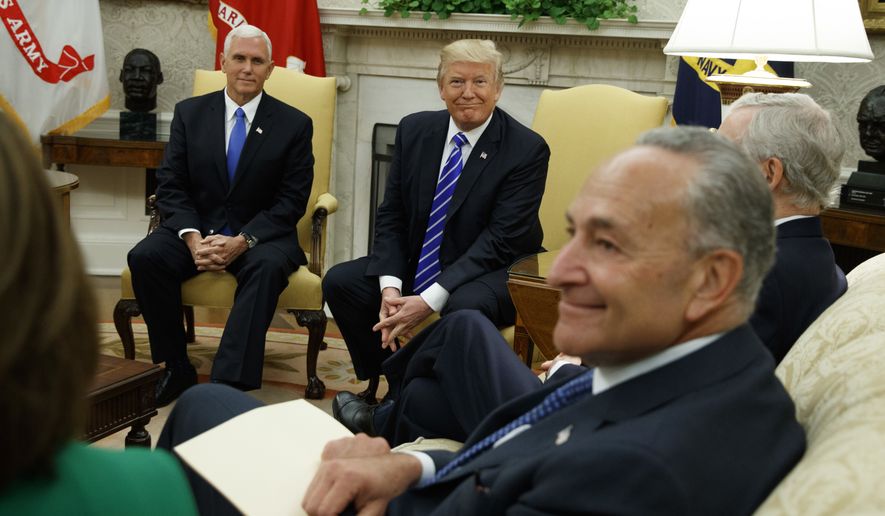President Trump confirmed Thursday that he’s considering working with Democrats on a plan that would eliminate the government’s debt ceiling, marking his latest veer away from standard GOP positions.
“It could be discussed,” Mr. Trump said. “For many years people have been talking about getting rid of debt ceiling altogether and there are a lot of good reasons to do that. So certainly that is something that could be discussed.”
The Washington Post reported earlier in the day that Mr. Trump and Senate Minority Leader Charles E. Schumer had agreed to make an attempt to do away with the government’s borrowing limit.
It’s part of a new detente Mr. Trump has struck with Democrats, who appear to have found a willing partner in a president still trying to gain his footing when dealing with Congress.
Following a Wednesday meeting with Mr. Schumer and House Minority Leader Nancy Pelosi, as well as GOP leaders, the president made a new round of calls to both Democrats Thursday morning.
Mrs. Pelosi said she even asked the president to make a statement assuring illegal immigrant “Dreamers” he won’t deport them, and the president quickly complied with a Twitter post to that effect.
Mr. Trump said the cooperation signals a new era of bipartisanship, after a presidential campaign insults and vitriol, and eight months of Democrats’ fierce resistance to Mr. Trump in office.
“I think we will have a different relationship than we’ve been watching over the last number of years. I hope so,” the president said. “I think that’s a great thing for our country. And I think that’s what the people of the United States want to see. They want to see some dialogue.”
The first fruit of the negotiations was the president’s agreement with Democrats on a short-term debt and spending deal.
And a longer-term end to the borrowing limit would be an even bigger breakthrough.
That’s long been a goal of Democrats and Wall Street, which argues the limit and the difficulty the government has in raising it lead to market instability.
Republicans have been less eager to ditch the debt ceiling, viewing it as an opportunity to work for stricter spending limits. The 2011 debt deal was a result of a debt limit debate. That deal helped produce two consecutive years of actual spending cuts for the first time since the 1950s.
House Speaker Paul D. Ryan ruled out an effort to nix the debt limit, saying that’s part of the Constitution’s grant of power to Congress to control the government’s spending.
“I think there’s a legitimate role for the power of the purse in Article I powers, and that’s something that we defend here in Congress,” he said.
The government’s debt ceiling stands at just shy of $20 trillion right now, and Congress is poised to pass an extension that will let the government borrow as much as it needs through Dec. 15.
Mr. Trump struck that deal Wednesday, undercutting Mr. Ryan and fellow Republicans who’d wanted a longer debt increase.
Debt votes are always difficult, and both parties use them to try to extract concessions in deal-making.
Mrs. Pelosi on Thursday said that a three-month debt increase means Democrats will have more “leverage” in December, when they have to revisit the issue again.
• Stephen Dinan can be reached at sdinan@washingtontimes.com.




Please read our comment policy before commenting.